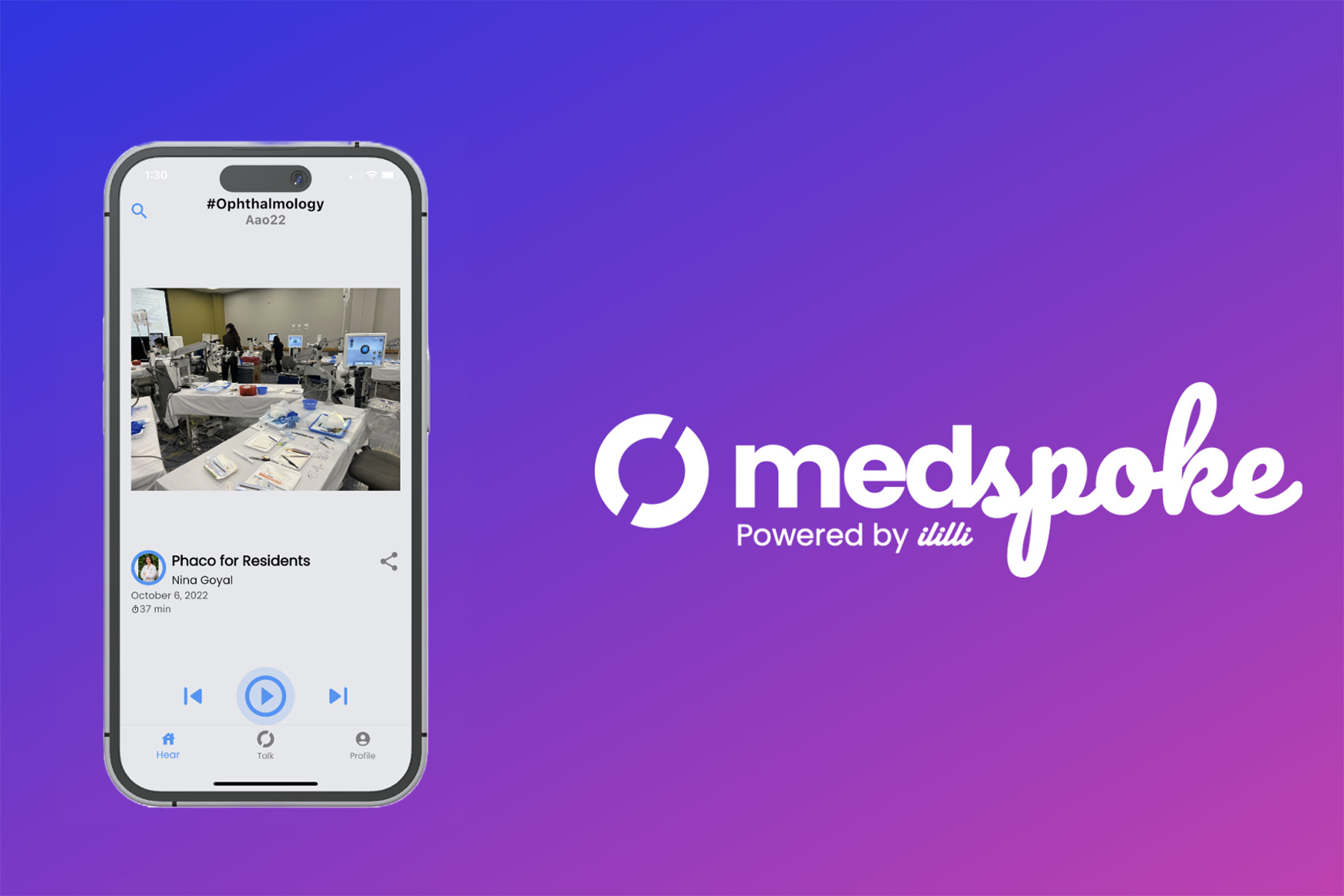In January 2021, Watzan saw the rise of podcasts and wanted to develop an audio platform that mixed social media and talk and allowed users to listen to short, 15-second audio clips about any of their favorite subjects posted by other users. Now, they are taking the tech behind that platform, which was called ililli, and spinning it off into a similar, but entirely medically focused platform called Medspoke.
This redesigned platform, which officially launched on April 5th, has and will continue to recruit key opinion leaders (KOLs) in various therapeutic categories who will be the only ones allowed to post 30-second “talks” related to their field. The platform has or plans to launch channels in Cardiology, Dermatology, Endocrinology, Hematology, Hepatology, Oncology, Ophthalmology, Neurology, Rheumatology, and Urology by the end of the year. Healthcare professionals (HCPs) interested in hearing these talks can download the app for free, click on the channel of their choice, and start listening.
PM360 spoke with Evan Johnson, Chief of Staff at Watzan and Head of Product Development and Strategy for Medspoke, about the launch of the platform.
PM360: Why did you decide to shift away from ililli and launch Medspoke?
Evan Johnson: When we built ililli, “social audio” was kind of the buzzword, then we realized that that wasn’t necessarily where pharma or medical media was going. Instead, HCPs told us they wanted a platform that is built for them and is easily navigable based on what they want. So that’s what is behind the whole overhaul toward Medspoke.
As you developed this new platform, what did you want to change about how it functions compared to ililli?
With ililli, the idea was, “How do we make audio Twitter?” Anyone could come in and talk about anything they wanted and they would code it with a hashtag, such as #ASCO2022. But what we’ve shifted to now is very much focused on channels. So if you click on the nephrology channel, then you will end up in a space with content from approved talkers, which was one of the things HCPs said was most important to them—having content from people they know they can trust. Then within each channel we can do subchannels, so if you’re interested in APOL1-mediated kidney disease (AMKD) under the nephrology space then you can click on that for talks on that topic. We can create these subchannels based on the kind of demand for content we are seeing.
How are you recruiting the KOLs for these various channels?
Right now, it can be a bit of a push or a pull model. In terms of pulling, our communities team will go out and try to identify who are the leading KOLs from a space and invite them to jump on a Zoom call to explain how the platform works, why they should be excited about it, why they should buy into the process, and see if they are interested in producing content.
And then there can also be a push function from the HCPs themselves. Hypothetically, if a lung cancer specialist at BYU reaches out and is interested in joining as a talker, then we will do our due diligence to vet them before approving them to post on the platform. But the focus is on quality, so the person doesn’t need to be a big name or have a big following, as long as we validate the content they intend to produce is of the highest of quality then we will let them join.
At launch, how many KOLs do you have producing content?
As of right now, we’ve been rolling out our Nephrology and Rheumatology channels, and we’re between four and five KOLs for both of those channels. Then we’re looking to roll out another channel per month as the year goes on. For example, I know the plan is to make our Ophthalmology channel live every day starting in July.
Will the talks always be limited to just 30 seconds or will KOLs eventually be able to go longer if they want?
As of right now, we haven’t had much demands or complaints around being limited by 30 seconds. Down the road we could increase the length limitations, but we find people tend to overestimate how long it’s going to take to say something and they may not even need 30 seconds. We have also ended up with some very intriguing media created by KOLs due to the limits.
For example, Dr. Y will talk about the most recent clinical trial data for a study that they’ve been following or Dr. B will be at a major conference and talk about the best places to get food nearby. One of the funny things we’ve heard from HCPs is that those food reviews are often some of the most useful talks because they may have never been in that city before. But in terms of length, a pizza review might take 12 seconds, but talking about the most recent clinical trial data might take 27.
In terms of users, will the people who had been using ililli roll over to Medspoke? And if so, what is the current user base?
You never want to give up users, so yes it will be a seamless transition for exiting ililli users as the app will automatically switch over for them. We do have some users who weren’t medically focused, so that’s probably going to be a surprise for them, but that was really a marginal use case community anyway.
Then, in terms of existing users we’re looking at tens of thousands. But our plan now is to take a sustainable staggered approach to grow that base. So, for example, now that we have a nephrology faculty in place our community team will champion the effort to grow the nephrology audience. Then it will be a staggered rollout to go to more and more HCPs every day as we launch each channel.
What are the opportunities for marketers within the platform?
This is one of the aspects that we’re quite proud of, which is we are the only audio offering that checks all the boxes for HCPs, KOLs, and brands. Now, of course, everyone’s going to say they’re the only option out there, so I understand if people take that with a grain of salt. But it is pretty apparent that audio in general is a rapidly emerging space.
For instance, and forgive me but this is back of the envelope math that we’ve done, something like 20% of all media is consumed in an audio format, but within HCP marketing only around 0.1% of all spend goes to audio. The main reason for that is a lack of content to put your stuff around. There’s only so many medical podcasts that get picked up by specialties, and even then we hear from KOLs with podcasts that they won’t take outside money or bring in sponsors since the podcast’s costs are covered by an association or a not-for-profit. Additionally, there have also been problems in the audio space around the ability to target your audience and problems around frequency capping.
We believe we can help marketers overcome a lot of these issues. Again, our talks are only 30 seconds, so the content is there for marketers to put their assets around without inundating listeners because there is a natural cadence to insert ads between talks. Marketers can create what we call talk ad units in which they get up to 30 seconds of audio, a static banner image that’s 250 x 300 or 300 x 600, and then a URL too. Marketers can have a campaign for brands up and live in 24 hours if they really wanted to.
How have you seen marketers use those talking units?
In some cases, they can use a KOL they work with or they can provide us with a script and we’ll get professional voice actors to take care of it free of charge for our clients. We work with the brands to get the right tone they want. Some brands want it to sound like a Marvel superhero while other want it to sound like a practicing clinician. And there are different use cases. We have seen marketers do booth drivers if it’s around a conference, education efforts, disease state awareness, etc. Then anytime we have someone doing sponsored content, such as getting a KOL to say something like, “This is the most recent trial data from Trial X from Company B. Here’s the results. Check out more here,” we will always include a disclaimer that makes it clear this was made in partnership with company B.
Looking more long term, how do you see this growing once you have established more channels?
Once we have established those 10 channels we are planning, there will still be an aspect of building the plane as it goes down the runway. Because within any given specialty there are dozens of subspecialties, so we expect will we need to continue to build subchannels like I mentioned previously within each of our channels. Ultimately, we want the platform to reflect the HCP environment as much as it can, so if someone is interested in a hyper-niche aspect of urology, then we want to make sure there is a channel for them.








